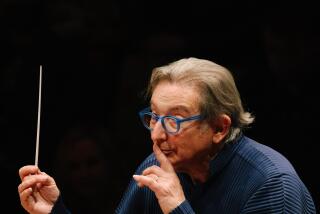Perahia blends styles with energy
The celebrated American pianist Murray Perahia has been performing solo shows in Los Angeles for more than 20 years, so familiarity may have been the cause for the particularly relaxed atmosphere at his recital in Royce Hall on Thursday evening. The audience apparently felt so at home with him that it saw no need to be on its best behavior. People coughed, snacked and scratched as if he were performing in their living room. Not one but two sets of jangling keys fell to the floor, which may have been some kind of record.
Luckily, Perahia’s focus was on the music. His playing cut through the din and made for a fascinating evening. The program consisted of works by 19th century German composers -- though Perahia didn’t always give the works the typical Romantic treatment. The opening piece, Beethoven’s Piano Sonata No. 16 in G Major, at times didn’t even sound like Beethoven. In fact, the third movement sounded so unfamiliar that one might have thought Perahia was substituting an alternative version for the finale.
But no, the difference was merely the pianist’s unique interpretation. Instead of conjuring images of dark Vienna drawing rooms lighted by candles, his stately vision of this piece suggested Sussex on a warm summer day.
The next selection was Schumann’s “Fantasiestucke,” which in contrast sounded entirely Romantic and brooding. Gone was the soft, measured playing and the delicate, reverberant tone. For Schumann, Perahia’s phrasing was much more elastic and his tone bolder and darker.
Interestingly, during the Beethoven, not a note sounded out of place, whereas with the “Fantasiestucke” cycle, Perahia seemed less interested in the perfection of his technique and more conscious of the emotional tension in each of Schumann’s tender vignettes.
After the intermission, Perahia brought these styles together. In his playing of Brahms’ Variations and Fugue on a Theme by Handel, the refinement he brought to his first piece was combined with the dark, Romantic sound he brought to the second.
These styles perfectly meshed with Brahms’ work, which masterfully blends 18th century Classicism and 19th century Romanticism. But Perahia made this performance more than just an intellectual exercise, bringing considerable energy to the score, giving the music a palpable bounce.
Most of all, Perahia never wallowed in the piece’s opportunities for virtuosity. Brahms, of course, was a master performer as well as a composer so the work is a showcase for technique, but Perahia’s confidence and intelligence ensured that his virtuosity was always at the service of the music and not the other way around.
More to Read
The biggest entertainment stories
Get our big stories about Hollywood, film, television, music, arts, culture and more right in your inbox as soon as they publish.
You may occasionally receive promotional content from the Los Angeles Times.










